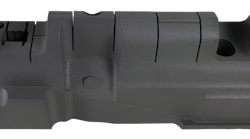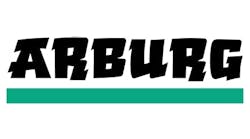Boston-based Fortify’s new 3-D printer, the Flux One, is a digital light projection printer that incorporates two unique modules: One that evenly distributes additives within the resin to improve strength or other attributes of the final product; and one that can precisely align reinforcing fibers in the resin. The printer, which began shipping in August, can make mold inserts and end-use parts.
The Continuous Kinetic Mixing (CKM) module accepts separately packaged standard liquid photopolymer resin and additives — which can be ceramic, metal or polymer particles or fibers that Fortify has selected and treated so they bond well and, in some cases, are magnetically responsive. The CKM module blends the additives with the resin and heats it as needed to keep the additives evenly distributed throughout the printing process. “Anybody else who’s in the light-cured polymer business doesn’t mess with fillers, because it’s challenging to work with, and the biggest challenge is that it settles out,” said Ben Arnold, VP of business development for Fortify.
The Fluxprint module controls a magnetic field that can orient all of the magnetically responsive fibers suspended in the liquid resin. The Flux One can direct its UV light precisely, curing resin down to the individual voxel level (akin to pixels in 2-D printing, voxels are the individual building blocks of a 3-D print). Fibers are locked into place once the resin is cured. Fluxprint can reorient all fibers in the remaining liquid resin, and the next portion of the layer is cured, locking those fibers into the new orientation. Layer by layer, the fibers can be oriented to optimize the desired attributes of the final part.
Fortify says the combination of these modules makes Flux One a faster, cheaper way to produce mold inserts for prototypes or short runs. Companies using it can produce tooling within days, for hundreds of dollars, rather than requiring weeks and thousands of dollars. “We’re doing the same thing molders do — we’re using reinforcing fiber to make a part stronger,” Arnold said. “And if a part is stronger and stiffer, it’s going to work better as a mold tool.” These stronger molds can produce more parts than unreinforced printed molds, or can be used to mold more challenging resins, such as nylon 6.
The mix and alignment of additives in an end-use part can be optimized for qualities other than strength, including electrical or thermal conductivity. Arnold said the Flux One can print jigs and fixtures for electronics manufacturing applications that require a small amount of conductance to allow for electrostatic discharge. Parts can also offer thermal conductivity improvements over unmodified plastics, but still not approaching the conductivity of metals, he said.
“The other thing that we’re doing differently than any of the other companies I’ve seen approach this is that we’re taking a much more focused effort on helping customers learn how to use the technology,” Arnold said. Fortify offers its customers an onboarding program to train them on how to get the most performance out of the Flux One printer. Fortify has a 30-ton Nissei all-electric injection molding machine in its facility it uses to run trials on customer parts made using 3-D printed molds.
David Tillett, associate editor
Contact: Fortify, Boston, 508-954-2407, [email protected], www.3dfortify.com
| Vital statistics | |
| Printer dimensions (inches) | 22.8 by 33.4 by 70/81 (door closed/door open) |
| Printer weight (pounds) | 500 |
| Build volume (inches) | 8 by 4.5 by 13 |
| Materials qualified for use in molds created by Flux One printer | TPU, acetal, ABS, PP, nylon 6, glass-filled nylon, PC |





